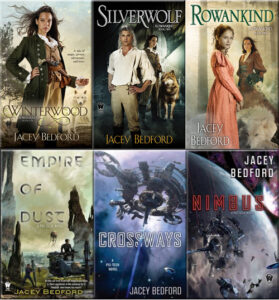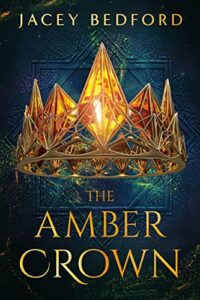Fantasy – Stealing from History by Jacey Bedford
I was never very good at history in school. Maybe it was the dry way it was delivered, or maybe I simply wasn’t ready for it. We never seemed to take history as a whole. We always ended up studying specific periods which were not connected to the period immediately before or after. So school history was a series of snapshots, not a continuous stream. Louis XI of France followed by the industrial revolution is a big disconnect.
My interest in history came long after school. It started with local history. The village where I live is not really old. There’s a farm with a door lintel dated 1642, but most of the houses, and the mill that provided work, date from around 1800. The mill had a water wheel which was fed from a mill pond, which in turn was topped up by an upstream pond which was (still is) the first industrial use of water on the river Dearne. The water then runs down the valley to a second mill in the next village, owned by the same people. And suddenly the industrial revolution makes more sense. I like history now.
I began writing in my teens, though the world will be very relieved to note that my first book (all six chapters of it) never saw publication. It was a teen dystopia peopled by characters who were thinly disguised versions of my favourite pop stars.
I never chose writing science fiction and fantasy. The genre chose me. It was what I read, so writing it seemed natural. Writers who have a massive best seller with their first book are few and far between. My first published book (Empire of Dust, a space opera) came out in 2014 but I wrote it back in 1998, so my overnight success took sixteen years. I now have seven books available, all published by DAW in the USA even though I’m a British writer. They consist of two trilogies, (one is science fiction and the other is historical fantasy) and the most recent book is another historical fantasy – this time a stand-alone called The Amber Crown.
I enjoy stealing from history, though I’m not averse to changing things to suit my story. My Rowankind trilogy (Winterwood, Silverwolf, and Rowankind) is set in Britain in 1800 – 1802 and follows history with a few alterations. Britain is at war with France. Napoleon is rampaging through Europe. King George III is going steadily mad (though I have a magical reason for that). There’s a servant-race, called the rowankind who were once helpmeets of the fae, but, for some reason no one seems to remember, they were called into the world of humans and are stuck. Witchcraft is strictly regulated and any practising witch who is not registered is summarily executed.
That’s just the background, the story is about Ross (Rossalinde) Tremayne, an unregistered witch, who captains her own privateer vessel with the help of a bunch of barely-reformed pirates and the jealous ghost of her dead husband. A deathbed visit to her estranged mother leaves her with a half-brother she didn’t know about, and a task she doesn’t want. The story continues on through all three books, but Winterwood can be read as a standalone.
People ask me if it’s difficult switching genres between science fiction and fantasy, but I don’t find it so. My books are character-led. I’m writing about people and it doesn’t really matter whether they are on a two-masted schooner in the middle of the Atlantic, or a star-spanning space ship out on the galactic rim. I like to mix adventure and mystery with a little romance and characters who are (I hope) real in the mind of my readers.
My most recent book, The Amber Crown also steals from history, though I’ve taken a lot of liberties. Rather than being set in Britain, it’s set in a fictional Baltic country called Zavonia, which is an analogue of Latvia/Lithuania with a lot of Polish influence in costume. I have, for instance, incorporated the Polish Winged Cavalry, hussars who went into battle with huge iron wings strapped to their backs, and who were the pre-eminent cavalry of Europe for the best part of 200 years. My writers’ group thought it unbelievable and thought I’d invented it, but it was real.
Again, The Amber Crown is really about the characters and it’s told through three viewpoints. Valdas is the captain of the king’s bodyguard who is in deep trouble when the king is killed. (That’s not a spoiler, it happens on the first page.) He’s accused of the murder and goes on the run, determined to find the real killer. Mirza is the witch-healer of a band of travelling refugees who is given the task of helping Valdas by the ghost of his dead king. Lind is the clever assassin who is beginning to regret taking the job, especially since the person who hired him seems to be a practitioner of magic. The three start out separately and come together to confront an adversary steeped in blood magic.
I’m a visual writer. My books play out in my head like a sprawling full-colour movie (though I don’t cast my characters from known actors). I have a lot of Pinterest boards which hold images from which I take inspiration. If you take a look here: you’ll find boards for Georgian history, which helped me to visualise the world of Winterwood, and boards dedicated to the ‘Baltic story, general research, costume, and even a board for the Polish Winged Hussars.
You can catch up with me at my website There’s more information about the book, and about my short stories, plus a link to my blog, and a contact page where you can sign up to my mailing list. Don’t worry, I won’t bombard you with spam. I’m always happy to hear from readers, writers and reviewers.
I’d like to thank Ju for inviting me to write for this fine blog.


